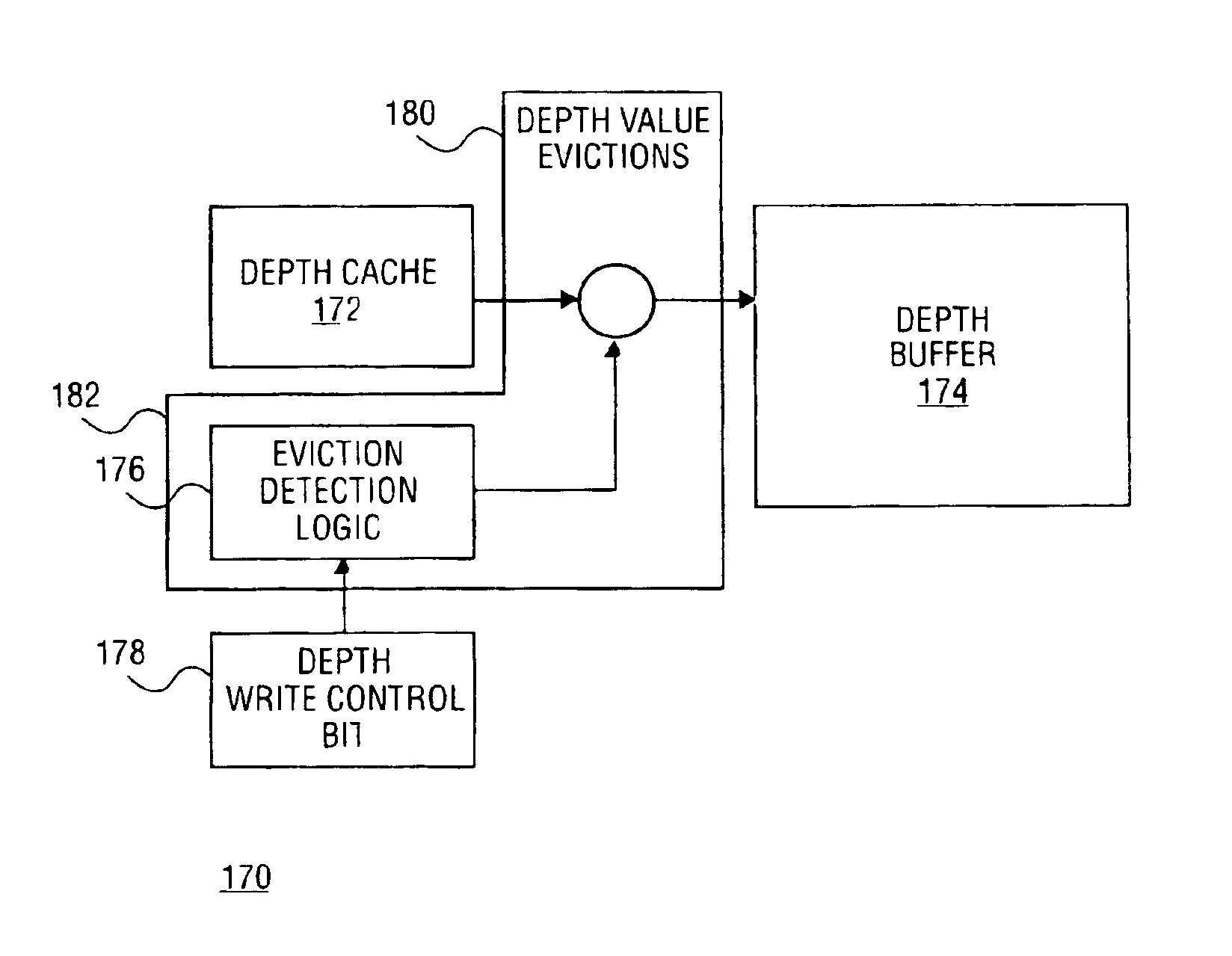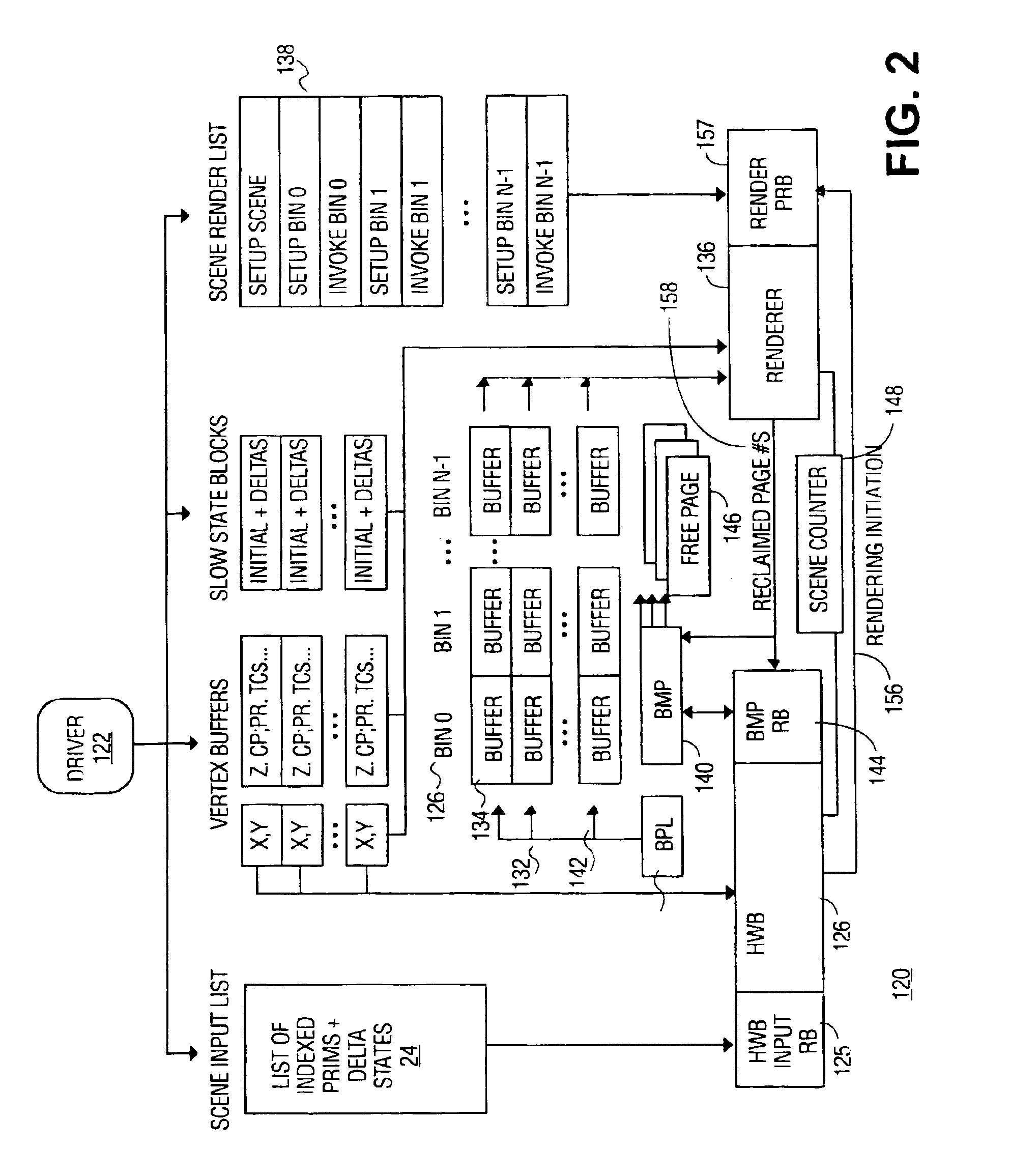Depth write disable for rendering
a write disable and depth buffer technology, applied in the field of graphics systems, can solve the problems of unnecessarily placing substantial load on the depth buffer, slowing the system operation,
- Summary
- Abstract
- Description
- Claims
- Application Information
AI Technical Summary
Benefits of technology
Problems solved by technology
Method used
Image
Examples
embodiment 160
[0030]Referring to FIGS. 2 and 3, an embodiment 160 of various graphics objects, for example geometric primitives (i.e. triangles, lines) 162, implemented on a zone rendering system 120 is illustrated. In zone rendering, a screen is subdivided into an array of zones 164 commonly screen-space rectangles although other geometric variants may be used as well. Each zone 164 is associated with a bin. Each bin 128 includes a chained series of command buffers 134 stored within non-contiguous physical memory pages. The bins 128 are thus preferably implemented as a chain of independent physical pages.
[0031]The process of assigning primitives (and their attributes) 162 to zones 164 is referred to as binning. “Bin”128 refers to the abstract buffer used for each zone—where a bin 128 will typically be realized as a series of instruction batch buffers 134. Binning performs the necessary computations to determine what primitives 162 lie in what zones 164 and can be performed by dedicated hardware ...
embodiment 170
[0041]FIG. 4 illustrates a block diagram of an embodiment 170 of a depth write disable configuration. The depth write disable configuration includes a memory controller 182 implementing eviction detection logic 176 to enable / disable write evictions from the internal render cache 172 to the corresponding depth buffer 174 in response to a control signal in the form of a enable / disable bit 178. When the depth write enable / disable bit indicates that depth buffer writes are disabled, evictions 180 from the render cache 172 (as typically occur during the rendering of the next zone 164) cause the evicted data to be discarded instead of being written to the depth buffer 174. The elimination of the final depth value writes reduces overall bandwidth requirements and therefore improves performance, especially in bandwidth-constrained system configurations.
[0042]When the depth write enable / disable bit indicates that depth buffer writes are enabled, the memory controller 182 performs a write bac...
embodiment 190
[0056]FIG. 6 is a flow diagram of an embodiment 190 for inhibiting depth value evictions from the depth cache 172 to depth buffer 174. In zone rendering, the internal render cache 172, which typically holds color and depth values, is initialized to a constant (i.e. clear) value (step 192). If required, the (constant) clear depth value is generated and written to depth buffer 174. Similarly, if required, the (constant) clear stencil value is written to depth buffer 174. A special primitive may be used to perform a fast clear of the depth or any other buffers.
[0057]A particular zone control register is made to be the active register during the processing of a zone control instruction from the instruction stream being stored in a corresponding ring buffer memory area (step 194). In a typical implementation, the graphics applications supply instructions into the instruction stream. The graphics-rendering engine decodes specific instructions from the instruction stream to find out what i...
PUM
 Login to View More
Login to View More Abstract
Description
Claims
Application Information
 Login to View More
Login to View More - R&D
- Intellectual Property
- Life Sciences
- Materials
- Tech Scout
- Unparalleled Data Quality
- Higher Quality Content
- 60% Fewer Hallucinations
Browse by: Latest US Patents, China's latest patents, Technical Efficacy Thesaurus, Application Domain, Technology Topic, Popular Technical Reports.
© 2025 PatSnap. All rights reserved.Legal|Privacy policy|Modern Slavery Act Transparency Statement|Sitemap|About US| Contact US: help@patsnap.com



